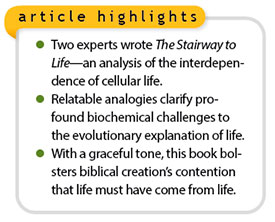 Rare is the science book that can hold even an average reader’s attention. But The Stairway to Life does just that. Coauthored by biochemist Laura Tan and biomedical engineer Rob Stadler, it carries you through the 12 steps needed to organize chemicals into a cell and demonstrates how the latest discoveries derail origin-of-life-by-nature scenarios.
Rare is the science book that can hold even an average reader’s attention. But The Stairway to Life does just that. Coauthored by biochemist Laura Tan and biomedical engineer Rob Stadler, it carries you through the 12 steps needed to organize chemicals into a cell and demonstrates how the latest discoveries derail origin-of-life-by-nature scenarios.
As an author in the same genre, I found myself admiring two particular attributes of The Stairway to Life. First, its clarity.
It’s hard to explain biochemical processes to a general audience. Those who try share the same challenges as an auto mechanic explaining engine diagnostics to someone who never peeked under a car’s hood. Oversimplifications can obscure the whole idea, but when the biochemistry gets tough, Drs. Tan and Stadler introduce brilliant analogies that clarify core concepts. For example, to illustrate the cellular process of ordering chemicals into DNA, they relate connecting train cars into a long train. They later extend the analogy with a train wreck. Experiments show that chemicals left to assemble themselves act like colliding train cars that never achieve biological sequences.
The authors so clearly explain the cell’s complicated construction that readers come to see for themselves why no nature-only process comes close to explaining how chemicals would self-organize into a cell. Trying to get chemicals to make a cell is like asking rocks to organize themselves into a city.
 This brings me to the second attribute I admired: the gracious tone. Tan and Stadler consistently show grace and respect to those who cling against all odds to these nature-only views. For example, before explaining origin-of-life laboratory work, they say on page 73, “This area of science is nearly powerless to distinguish reality from wishful thinking. Desperation in the search for evidence often encourages one to perceive any form of evidence, no matter how unlikely, as compelling.” Sympathy is housed here. By considering motives with grace, the authors demonstrate deep respect for their opposition. Needless provocation is simply not found in this book. Salt seasons the book throughout, making the latest science pleasant even for doubters.
This brings me to the second attribute I admired: the gracious tone. Tan and Stadler consistently show grace and respect to those who cling against all odds to these nature-only views. For example, before explaining origin-of-life laboratory work, they say on page 73, “This area of science is nearly powerless to distinguish reality from wishful thinking. Desperation in the search for evidence often encourages one to perceive any form of evidence, no matter how unlikely, as compelling.” Sympathy is housed here. By considering motives with grace, the authors demonstrate deep respect for their opposition. Needless provocation is simply not found in this book. Salt seasons the book throughout, making the latest science pleasant even for doubters.
For that matter, the scientific quality and gracious tone of this book should make it appealing not just to skeptics but to any interested reader. Given my biochemistry training, I initially expected that the most this book would do for me is polish my already-solid grasp on the origin-of-life topic. But Stairway’s new information updated and upgraded my grip on these issues.
This valuable volume is stocked with airtight references reporting newfound challenges for nature to kickstart life. Tan and Stadler precisely perceive and artfully explain the biochemical hurdles to origin-of-life scenarios. For example, what have we learned about the cell membrane? The authors write, “We have another critical interdependence: the membrane requires embedded proteins to achieve its semipermeable functionality, but the embedded proteins require the semipermeable membrane to produce the ATP that fuels their function” (page 144). Thus, as science expands our understanding of the tiniest pieces of cellular biology, it affirms with increasing rigor this axiom: it takes a cell to make a cell.
Up-to-date research and brilliant insights could only come from authors with an intimate understanding of the issues at hand. Nature-only origins theories suffer new impossible hurdles with every major discovery about the interdependence inside a cell’s key parts. The Stairway to Life instills gobs of confidence for those who believe in the Creator and presents its arguments with clarity and grace to reach doubters.
*Dr. Thomas is a Research Associate at the Institute for Creation Research and earned his Ph.D. in paleobiochemistry from the University of Liverpool.





















